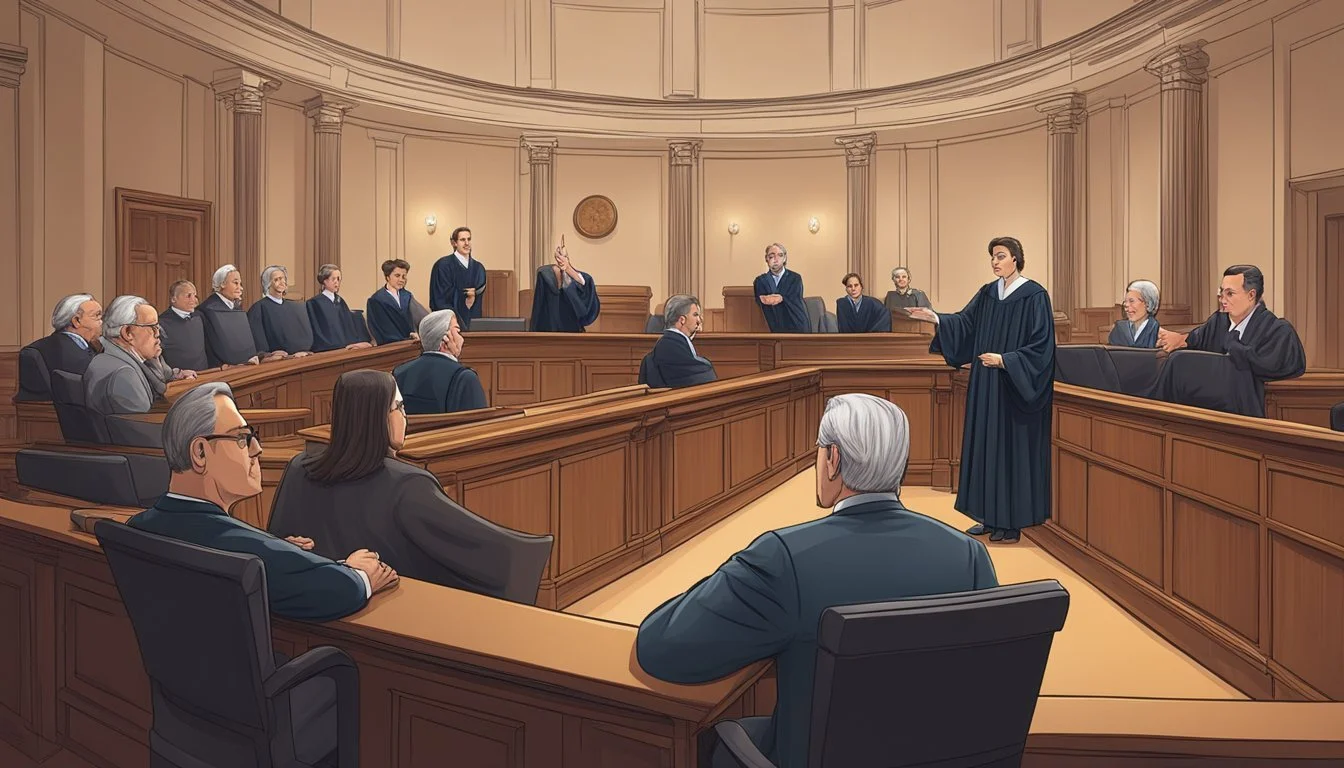Inside the Mind of Evil: Gripping Documentary Serial Killer Exposes the Dark Truth Behind Notorious Crimes!
Serial killer documentaries offer a chilling glimpse into the minds of society's most notorious criminals. These films and series explore the dark motivations, gruesome crimes, and eventual capture of individuals who committed multiple murders over time. By examining real cases through interviews, archival footage, and expert analysis, they provide viewers with a deeper understanding of criminal psychology and investigative techniques.
The best serial killer documentaries balance factual information with compelling storytelling to educate and engage audiences. Popular examples include "Night Stalker: Hunt for a Serial Killer" on Netflix, which details the search for Richard Ramirez, and "Aileen: Life and Death of a Serial Killer," which examines the complex case of Aileen Wuornos. These works often raise important questions about criminal justice, mental health, and societal factors that may contribute to the development of serial killers.
While the subject matter is undeniably dark, many viewers find these documentaries fascinating for their insights into human nature and the criminal mind. They serve as cautionary tales and historical records, preserving the stories of victims and the efforts of law enforcement to bring perpetrators to justice. As true crime content continues to captivate audiences, serial killer documentaries remain a powerful and thought-provoking subgenre.
Understanding Serial Killers
Serial killers have long captivated public attention due to their shocking crimes. They often display distinct psychological characteristics and patterns of behavior that set them apart from other violent offenders. Historical analysis reveals how society's understanding of these criminals has evolved over time.
Psychological Profiles
Serial killers frequently exhibit antisocial personality disorder, narcissism, and lack of empathy. Many experienced childhood trauma or abuse. Some, like Jeffrey Dahmer, display sexual deviance and paraphilias.
Motivations vary but can include power, control, or sexual gratification. Killers may target specific victim types based on appearance, occupation, or vulnerability.
Law enforcement uses psychological profiling to identify suspects. This involves analyzing crime scenes, victim selection, and behavior patterns to create offender profiles.
Despite popular myths, not all serial killers are intelligent or charming. Their abilities to evade capture often stem from careful planning and victim selection rather than exceptional skills.
Historical Analysis
The term "serial killer" emerged in the 1970s, but the phenomenon has existed throughout history. Jack the Ripper's 1888 London murders marked a turning point in public awareness.
Early 20th century killers like H.H. Holmes capitalized on urbanization and increased mobility. The mid-20th century saw infamous cases like the Boston Strangler and Zodiac Killer.
Improved forensics and investigative techniques in recent decades have aided law enforcement. DNA analysis has solved many cold cases and linked previously unconnected crimes.
True crime media has increased public fascination with serial killers. Documentaries and books provide in-depth looks at notorious cases, though some criticize this attention as potentially glorifying killers.
Notorious Figures
Several serial killers have gained infamy through their heinous crimes, becoming the subjects of numerous documentaries. These individuals shocked the public with their brutal acts and complex psychologies.
Jeffrey Dahmer
Jeffrey Dahmer murdered 17 men and boys between 1978 and 1991. His crimes involved dismemberment, necrophilia, and cannibalism. Dahmer's seemingly normal facade allowed him to evade capture for years.
He lured victims to his Milwaukee apartment, where he drugged and killed them. Dahmer kept body parts as trophies and experimented with crude attempts at creating "zombies" by drilling into victims' skulls.
Dahmer was arrested in 1991 after a potential victim escaped. He was sentenced to 15 life terms but was beaten to death by a fellow inmate in 1994. Documentaries explore Dahmer's troubled childhood, alcoholism, and the failures of law enforcement in catching him sooner.
Ted Bundy
Ted Bundy killed at least 30 young women across seven states in the 1970s. His good looks and charisma allowed him to gain victims' trust before abducting and murdering them.
Bundy often pretended to be injured or an authority figure to lure women. He decapitated some victims and kept their heads as mementos. Bundy escaped custody twice, committing more murders while on the run.
Caught in 1978, Bundy was executed in Florida in 1989. He confessed to 30 murders but the true number may be higher. Documentaries examine Bundy's psychology, his ability to blend into society, and his narcissistic personality.
John Wayne Gacy
John Wayne Gacy murdered 33 young men and boys in Chicago between 1972 and 1978. Known as the "Killer Clown," Gacy performed at children's parties dressed as "Pogo the Clown."
Gacy lured victims to his home, where he sexually assaulted and strangled them. He buried 26 bodies in the crawl space beneath his house. Gacy's respectable image as a successful businessman and community volunteer masked his crimes.
Arrested in 1978, Gacy was executed in 1994. Documentaries explore his abusive childhood, his double life, and the search for additional victims that continues today.
Aileen Wuornos
Aileen Wuornos killed seven men in Florida between 1989 and 1990. She is often called the first female serial killer, though this is inaccurate.
Wuornos worked as a prostitute and claimed her victims were clients who had assaulted her. She shot the men and robbed them, abandoning their vehicles.
Arrested in 1991, Wuornos was executed in 2002. Documentaries examine her traumatic childhood, her relationship with girlfriend Tyria Moore, and debates over whether her crimes were self-defense or premeditated murder.
Richard Ramirez
Richard Ramirez, known as the "Night Stalker," terrorized Los Angeles in 1984-1985. He broke into homes to rape, torture, and kill his victims, ranging from children to the elderly.
Ramirez used a variety of weapons and left Satanic symbols at crime scenes. His random victim selection and the brutality of his attacks sparked widespread fear.
Captured in 1985, Ramirez was sentenced to death but died of natural causes in 2013. Documentaries explore his substance abuse, Satanism, and the intensive manhunt that led to his capture.
True Crime Documentary Evolution
True crime documentaries have undergone a significant transformation over the decades. Technological advancements and shifting audience preferences have driven this evolution, resulting in more immersive and captivating productions.
Early Documentaries
The 1980s marked a turning point for true crime documentaries. Films like "The Thin Blue Line" (1988) set new standards for investigative journalism in the genre. These early productions often relied on archival footage and expert interviews to reconstruct events.
Television networks began producing documentary series focused on serial killers. "America's Most Wanted" debuted in 1988, combining reenactments with real-life appeals for information. This format proved popular and influential.
Modern-Day Productions
Netflix revolutionized true crime documentaries with "Making a Murderer" in 2015. This series sparked a new wave of binge-worthy productions. Streaming platforms invested heavily in the genre, resulting in high-quality series like "The Ripper" and "American Murder: The Family Next Door."
Modern documentaries utilize advanced filmmaking techniques. They often incorporate dramatic reenactments, CGI reconstructions, and immersive soundscapes. Series like "Conversations with a Killer" and "Memories of a Murderer: The Nilsen Tapes" use archival audio to bring viewers closer to the subjects.
These productions focus on in-depth storytelling, exploring not just the crimes but their social and psychological contexts. They often challenge official narratives and highlight systemic issues within law enforcement and the justice system.
Case Studies
Documentary films provide in-depth examinations of infamous serial killer cases, offering insights into investigative techniques and landmark breakthroughs.
Investigative Procedures
"The Jeffrey Dahmer Files" explores the meticulous police work that led to Dahmer's capture. Detectives employed forensic analysis, witness interviews, and crime scene reconstruction to build their case.
"American Murder: The Family Next Door" showcases modern investigative methods, including social media analysis and GPS tracking, in solving the Chris Watts case.
The "Grim Sleeper" documentary highlights the use of familial DNA to identify Lonnie David Franklin Jr. after decades of eluding capture.
Breakthrough Cases
"The Confession Killer" examines Henry Lee Lucas, who falsely confessed to hundreds of murders. This case exposed flaws in interrogation techniques and the dangers of relying solely on confessions.
"Life and Death of a Serial Killer" revisits Aileen Wuornos, shedding light on the complexities of profiling female killers.
The "Yorkshire Ripper" case, chronicled in various documentaries, demonstrates how advances in forensic science helped catch Peter Sutcliffe after a prolonged manhunt.
"The Raincoat Killer" documents South Korean investigators' use of psychological profiling to apprehend a serial killer, showcasing cross-cultural investigative approaches.
Impacts on Society
Documentary series about serial killers have far-reaching effects on public perceptions and media portrayals of violent crimes. These productions shape how people understand and respond to real-world criminal cases.
Media Representation
Serial killer documentaries often sensationalize gruesome details to boost viewership. This can lead to an overemphasis on the killers themselves rather than the victims or survivors. Many productions focus intensely on the killer's psychology and motives.
Some documentaries provide valuable insights into criminal investigations and legal proceedings. However, others may glorify the perpetrators or present misleading information. The true crime genre walks a fine line between education and exploitation.
Responsible filmmakers strive to give voice to survivors and families of victims. They aim to honor those impacted while examining societal factors that enable serial killers. Ethical considerations are crucial when depicting real crimes and real people.
Public Perception
Exposure to serial killer documentaries can alter how viewers perceive violent crime and its prevalence. Some may develop an exaggerated fear of rare but dramatic crimes like serial murders. Others become desensitized to violence through repeated exposure.
These productions often spark public fascination with notorious killers. This can overshadow the experiences of survivors and victims' families. It may also inspire copycats seeking infamy.
At the same time, documentaries can raise awareness about issues like sexual assault and victim advocacy. They may motivate viewers to support related causes or be more vigilant about personal safety. Critical viewing and fact-checking are important when consuming true crime content.
Criminal Justice and Legal Responses
Serial killer documentaries often highlight the complex interplay between law enforcement efforts and legal proceedings. These films shed light on the challenges faced by investigators and prosecutors in bringing perpetrators to justice.
Law Enforcement Challenges
Police departments face numerous obstacles when pursuing serial killers. Limited resources and manpower can hinder investigations, especially in cold cases like Jack the Ripper. Jurisdictional issues sometimes arise, complicating efforts to connect related crimes across different areas.
The Grim Sleeper case in Los Angeles exemplifies the difficulties in tracking elusive suspects. Despite a 14-year hiatus between killings, detectives persisted in their search. Advanced DNA techniques ultimately led to the arrest of Lonnie Franklin Jr. in 2010.
Unsolved cases continue to frustrate law enforcement. The Zodiac Killer investigation remains open decades later, showcasing the enduring nature of some serial killer mysteries.
Legal Precedents
Serial killer trials often set important legal precedents. The prosecution of Robert Durst involved novel uses of evidence, including documentary footage that some argued blurred the lines between journalism and law enforcement.
In Brazil, the case of Wallace Souza raised ethical questions. The television host was accused of orchestrating murders to boost ratings for his crime show. This unusual scenario challenged traditional notions of criminal liability.
Courts must carefully balance the rights of defendants with public safety concerns. High-profile serial killer trials frequently test the limits of admissible evidence and fair trial procedures. These cases can shape future prosecutions and legal strategies.
Controversial Debates and Criticism
Documentary series about serial killers have sparked intense debates over ethical implications and potential consequences. Critics argue these productions raise concerns about victim exploitation and the glorification of violent criminals.
Ethical Concerns
Many question the ethics of profiting from real-life tragedies. Netflix's "Monster: The Jeffrey Dahmer Story" faced backlash for allegedly not seeking consent from victims' families. Some relatives expressed feeling re-traumatized by the show's graphic depictions.
Critics argue these documentaries can cause further pain to survivors and loved ones. There are also concerns about privacy violations and the potential for inaccurate portrayals.
Advocates contend that well-made series like "I'll Be Gone in the Dark" can raise awareness and even aid investigations. The show about the Golden State Killer case helped renew public interest, potentially contributing to the eventual arrest.
Glamorization of Crime
A major criticism of true crime documentaries is their potential to glorify killers. Shows like "Extremely Wicked, Shockingly Evil and Vile" have been accused of romanticizing criminals through charismatic portrayals.
Critics worry this approach may inspire copycat crimes or foster an unhealthy fascination with serial killers. There's concern that focusing on the perpetrators' perspectives can overshadow victims' stories.
Defenders argue that understanding criminal psychology is valuable for prevention. Series like "Making a Murderer" have also highlighted flaws in the justice system, leading to renewed legal scrutiny in some cases.
The debate extends to LGBTQ+ representation, with some arguing that projects like "Monster" reinforce harmful stereotypes about queer individuals.
Beyond the Screen
True crime documentaries about serial killers have impacts that extend far beyond entertainment. They shape public perceptions and can influence real-world efforts to prevent future crimes and educate communities.
Prevention Strategies
Law enforcement agencies study serial killer cases to develop more effective prevention tactics. The FBI's Behavioral Analysis Unit, featured in "Mindhunter," uses criminal profiling to identify potential suspects. Advanced DNA analysis, highlighted in "I'll Be Gone in the Dark," helps solve cold cases and deter would-be offenders.
Improved surveillance technologies and community policing strategies aim to stop killers before they can claim multiple victims. Mental health interventions target at-risk individuals who exhibit concerning behaviors. Some jurisdictions have implemented early warning systems to flag patterns of suspicious activity.
Education and Awareness
Documentaries like "Maury Terry's Ultimate Evil" raise public awareness about serial killer psychology and methods. This knowledge empowers potential victims to recognize danger signs and take precautions. Schools incorporate safety lessons inspired by true crime cases into their curricula.
Support groups for survivors and families of victims, often featured in documentaries, provide healing and advocacy. They push for legal reforms and victim support services. Public seminars educate communities on personal safety and reporting suspicious behavior.
Media literacy programs teach critical analysis of true crime content. This helps viewers separate facts from sensationalism and understand the broader societal factors contributing to violent crime.
Conclusion
Serial killer documentaries offer viewers a unique window into the darkest corners of human behavior. These films explore the motives, methods, and impact of society's most notorious criminals.
Documentarians employ various techniques to tell these chilling stories. Interviews with experts, archival footage, and dramatic reenactments bring depth to the narratives.
Many documentaries focus on well-known cases like Jeffrey Dahmer or Aileen Wuornos. Others shed light on lesser-known killers or unsolved mysteries.
These films often raise important questions about criminal justice, mental health, and societal factors. They can prompt discussions on prevention and rehabilitation.
Ethical considerations play a key role in how filmmakers approach their subjects. Balancing sensitivity to victims with the pursuit of truth presents ongoing challenges.
As the genre evolves, new perspectives and storytelling methods continue to emerge. Virtual reality and interactive elements may shape future productions.
Serial killer documentaries remain a compelling subgenre of true crime. They satisfy curiosity while serving as cautionary tales about the extremes of human nature.







